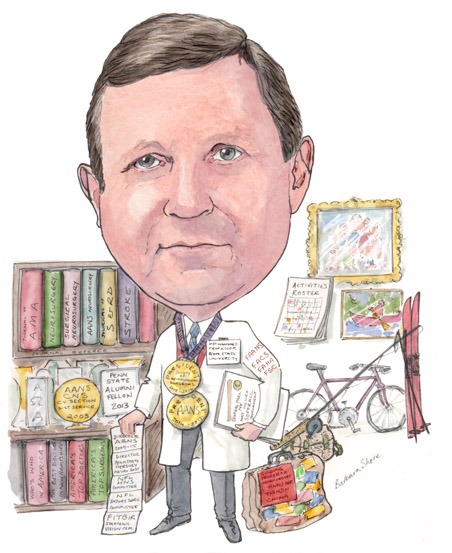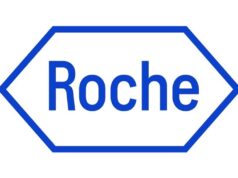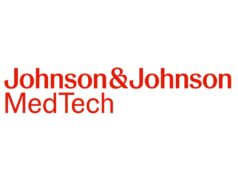
What drew you to medicine and to neurosurgery in particular?
At the start of my senior year in high school I was not even certain I would go to college. No one in my family had done so and there was no way my parents could afford to pay college tuition. During high school I had worked on a loading dock, as a house painter and a foundry worker and I knew I did not want to do those kind of jobs for the rest of my life. So, I visited a Navy recruiter and told him I wanted to be a fighter pilot. To my astonishment, he told me that pilots needed a college degree. So, I was back to figuring out how to pay for college. I still remember the feeling of relief and gratitude when I found out I had obtained scholarship money for my college education.
During college I lost my enthusiasm for naval aviation and was encouraged to apply to medical school. I received an invitation to interview at the Penn State College of Medicine. Shortly before that interview I picked up a short biography of Harvey Cushing, the founder of neurosurgery, for no particular reason. Serendipitously, my first interview at the Medical Center was with Richard Bergland, who then chaired the Division of Neurosurgery. Dr Bergland’s first question to me was, “Who are your medical heroes?” Having none, but knowing that an answer was required, I replied that I had a great admiration for the accomplishments of Harvey Cushing. After a few questions to see if I really knew anything about Cushing and his career, Dr Bergland waxed eloquent about the great man for the rest of the interview. I doubt that I said 15 words after the first few minutes but when I left for my next appointment he shook my hand, patted me on the back and complimented me on an excellent interview. I received my acceptance from Penn State shortly thereafter. I later learned that Bergland idolised Harvey Cushing. A few weeks after starting medical school, Dr Bergland contacted me and asked if I would like to work in his lab. In those long ago days had the Professor asked you to paint his house you would have said yes, with enthusiasm, and this was a much better offer. So, after a few weeks in medical school I never really considered a specialty other than neurosurgery.
Who have been your greatest influences and what advice from them do you still remember?
I do not recall many specific pieces of advice but there are a large number of people who, through actions rather than words, have had a profound effect on me. At the top of the list is Kimberly Harbaugh, a neurosurgeon who is also my wife. Kim’s devotion to her family and her patients is wondrous to behold. She is the best doctor and the best person I know. My maternal grandfather, Curvin Kinard, with whom I lived for much of my childhood, also stands out. He was a brilliant but self-educated man who convinced me early in my life that talent was not worth much without hard work and optimism—but the combination could accomplish almost anything. Finally, Dr Richard Saunders, my boss for most of my resident and faculty career at Dartmouth, combined great ability with the characteristics of honesty, integrity, loyalty and humility that make him an outstanding role model.
What have been your proudest moments?
Marrying Kim and the birth of my children dwarf everything else. Professionally, I have been honoured to serve as a director of the American Board of Neurological Surgery from 2009–2015, president of the American Association of Neurological Surgeons for 2014–2015 and president of the Society of Neurological Surgeons for 2015–2016. This recognition by my peers means a lot.
How has neurosurgery evolved since you began your career?
During my 30-year career neurosurgery has progressed tremendously. Neurosurgeons now treat more patients with lower risk, shorter hospital stays, less pain and better outcomes than when I was a resident. When I finished my residency in 1985 endovascular neurosurgery did not exist. Today the majority of intracranial vascular problems are being treated endovascularly and the technology continues to develop at a rapid pace. In 1985 functional neurosurgery was limited to destructive procedures using open surgery or focused radiation. Today, we have added non-destructive procedures such as deep brain stimulation that has been shown to be very effective for movement disorders. This kind of non-destructive functional neurosurgery may also prove to be a valuable treatment for a wide range of neurological and neurobehavioural disorders such as depression, addiction and obesity. Spine surgery for a neurosurgeon in 1985 was largely limited to decompressive procedures. Today, we have a wide array of options to treat spine disease. I tell my residents that it is important for them to be good doctors, not just technicians, because the procedures we are teaching them today will almost certainly not be the procedures they will be doing in 15 years.
What have your biggest achievements as president of the American Association of Neurological Surgeons (AANS, 2014–2015) been?
The AANS is a very complicated organisation that includes the American Association of Neurological Surgeons, a 501(c)(6) organisation, the American Association of Neurosurgeons, a 501(c)(3) organisation, the Neurosurgery PAC, an affiliated foundation—the Neurosurgery Research and Education Foundation, a data management company, the NeuroPoint Alliance and our own publishing company, the Journal of Neurosurgery Publishing Group. These various entities within the umbrella of the AANS are necessary to accomplish our goals of support for neurosurgical education and research, achieving quality improvement in neurosurgery, public advocacy for our specialty and service to our members. I believe I have made significant changes in the governance structure of the AANS that will allow all of these entities to work together seamlessly. During my tenure we have also greatly increased the international footprint of the AANS and have put in place the infrastructure to be sure that our international presence continues to expand.
What is the theme of this year’s AANS annual meeting and what will the highlights be?
The meeting will be held in Washington, DC and its theme is Neurosurgery’s Founding Principles. Our specialty was established on a sound foundation by Harvey Cushing and I believe it has flourished because we have adhered to our founding principles. Now we are in a time of turbulent change in our healthcare system and, with increasing frequency, we are being told that it would be expedient to abandon those founding principles. I hope our meeting will reinforce the principles of research and innovation, scholarship, autonomy, integrity and humility. Neurosurgery—a vigorous, exciting specialty during its first century—will continue to grow and prosper if we remain true to our founding principles.
I think the meeting will have many highlights. For the first time we are going to have a Sunday forum devoted entirely to residents, fellows and medical students’ presentations as well as an international symposium for presentations from our colleagues from abroad. Our opening session will be based on the idea that the principles of hard work, preparation, dedication, focus and endurance that are necessary for success in sports are also necessary for success in neurosurgery. Bill Walton and Peyton Manning will be speaking at this session, after which an opening reception will be held in the American History Museum of the Smithsonian. Our breakfast seminars, plenary sessions and subspecialty sessions will present the latest scientific information in the broad field of neurological surgery. We will also be offering courses for the physicians’ assistants and nurse practitioners who work closely with neurosurgeons in patient care. We have a number of non-neurosurgical speakers including Jonathan Turley (constitutional scholar), James Capretta (healthcare policy expert), Sally Satel (neuroscientist), Spencer Wells (geneticist) and our Cushing Orator, Charles Krauthammer (physician, writer and political commentator). I think it will be a very interesting and informative meeting.
What are your current research interests focused on?
My current research is focused in two areas: 1) Clinical trial design—specifically looking at the ability to design prospective, audited registries in such a way that we can draw causal inferences from the data using statistical techniques such as propensity analysis and 2) Computer modelling of intracranial aneurysms to determine the effect of aneurysm size and shape on risk of rupture.
As a professor of neurosurgery and director of a neurosurgery residency programme, what advice would you give to someone just starting out in the field?
Neurosurgery is a vital, vigorous and expanding specialty. If you adhere to our founding principles of research and innovation, scholarship, autonomy, integrity and humility you and the specialty will prosper. Always remember that it is a privilege to be a neurosurgeon and that before you can be a great neurosurgeon you have to be a good doctor.
What new research and technology are you keeping a close watch on?
I think we are entering an era when the use of appropriately constructed, continuous, prospective, audited registries will allow us to refine our operative indications, improve the quality of our care and reach consensus on best practices. This Science of Practice approach will, I believe, largely replace the present evidence based medicine algorithm that relies on intermittent cohort, case control and randomised studies and the generation of guidelines documents that are often of little value.
What has been your most memorable case and why?
I would not be able to pick one particular case. My favourite cases are brain arteriovenous malformations because I think they are very challenging and in the correctly chosen patients have excellent outcomes. I have done a number of giant aneurysm operations using cardiopulmonary bypass and circulatory arrest, which were very memorable cases, but the indications for this kind of surgery have largely gone away with newer endovascular neurosurgery options. Finally, I have done more than 2,000 carotid endarterectomies and I think I have been able to refine this operation through the use of regional anaesthesia, dual antiplatelet agents and other operative nuances to the point where it is a very low risk, minimally invasive and very cost-effective procedure.
What are your interests outside of medicine?
My time outside of my profession is almost completely taken up by my family (my wife and five children, three still at home) and their various activities. There are lots of things that I have done and enjoy (fishing, bicycling, alpine and nordic skiing, canoeing) that I almost never have time for now. Our neurosurgery department does have a softball team that competes each year in the national neurosurgery softball tournament in Central Park in NYC and I participate (now mainly as a coach) in that.









